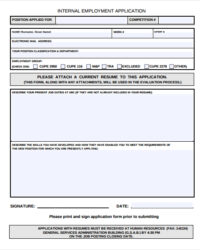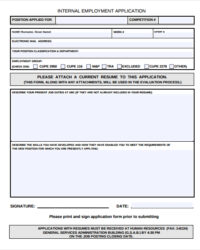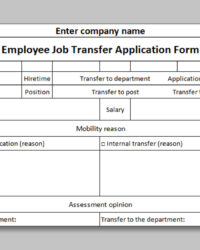Standardized forms offer several advantages. They clarify expectations for applicants, ensuring all essential information is presented. This simplifies the review process for hiring managers, allowing for efficient talent assessment and informed decision-making. Furthermore, structured applications promote fairness and equal opportunity by providing a level playing field for all internal candidates. They also enhance the professionalism of the internal mobility process and contribute to a positive candidate experience.
This article will further explore the development, implementation, and strategic utilization of these valuable tools within organizations, covering best practices, common challenges, and potential benefits for both employees and employers.
Key Components of an Internal Application Form
Effective internal application forms facilitate clear and consistent information gathering. Key components ensure comprehensive candidate profiles for streamlined evaluation.
1. Current Role Information: This section captures the applicant’s current position, department, and start date. It provides context for their application and helps assess internal career progression.
2. Target Position Details: Applicants specify the desired role and department. This clarifies the intended career move and ensures alignment with organizational needs.
3. Skills and Qualifications Summary: This section allows applicants to highlight relevant skills, qualifications, certifications, and training. It demonstrates suitability for the target role.
4. Experience and Accomplishments: Applicants detail relevant experience, quantifiable achievements, and contributions in previous roles. This provides concrete evidence of their capabilities.
5. Reasons for Application: This section explores the applicant’s motivation for seeking the new role and their perceived alignment with the target position and team.
6. References (Optional): Including internal references can provide additional insights into the applicant’s performance and suitability. Clear guidelines on reference collection should be provided.
7. Managerial Approval (Optional): A section for current manager sign-off can facilitate transparent communication and ensure alignment with departmental needs and workforce planning.
A well-designed form ensures consistent data collection, facilitates objective evaluation, and supports informed decision-making in internal hiring processes. These components contribute to a fair and efficient internal mobility program.
How to Create an Internal Job Application Template
Creating a standardized internal application template ensures consistency and fairness in internal hiring processes. A well-designed template streamlines applicant tracking and simplifies candidate evaluation for hiring managers.
1: Define Essential Information: Determine the crucial data points required from applicants. This includes current role, target position, skills, qualifications, experience, and reasons for applying. Consider incorporating optional sections for internal references and managerial approval.
2: Structure the Template: Organize the information logically into distinct sections. Use clear headings and subheadings to guide applicants and ensure all required information is provided. Group related fields together for improved readability and ease of completion.
3: Choose an Accessible Format: Select a format that is easily accessible and editable by all employees. Common options include word processing documents, fillable PDFs, or online forms. Ensure compatibility across different operating systems and devices.
4: Provide Clear Instructions: Include concise and unambiguous instructions for each section. Explain the purpose of each field and the type of information required. Offer examples where necessary to clarify expectations.
5: Ensure Legal Compliance: Review the template to ensure compliance with all relevant employment laws and regulations. Avoid requesting information that could be used for discriminatory purposes.
6: Test and Refine: Pilot the template with a small group of employees to identify any areas for improvement. Gather feedback on clarity, usability, and completeness. Revise the template based on feedback received.
7: Communicate and Implement: Communicate the new template to all employees and provide training on its use. Make the template readily available through internal communication channels or the company intranet.
A well-structured, clearly defined, and accessible template promotes efficiency and fairness in internal hiring, supporting both applicants and hiring managers throughout the internal mobility process. Regular review and refinement maintain the template’s relevance and effectiveness within the organization.
Standardized application materials provide a structured framework for internal mobility, ensuring consistency, fairness, and efficiency in talent management. These tools streamline the application process, facilitate objective candidate evaluation, and promote transparency within organizations. From outlining essential components to detailing creation and implementation strategies, this exploration underscores the value of well-defined procedures for internal hiring. Leveraging such structured approaches supports informed decision-making, strengthens internal talent pipelines, and contributes to a positive employee experience.
Organizations seeking to optimize internal mobility programs should prioritize the development and implementation of effective application procedures. This proactive approach fosters a culture of internal growth, facilitates career progression, and strengthens overall organizational performance by ensuring the right individuals are placed in the right roles. The strategic use of these resources ultimately contributes to a more engaged, productive, and successful workforce.


